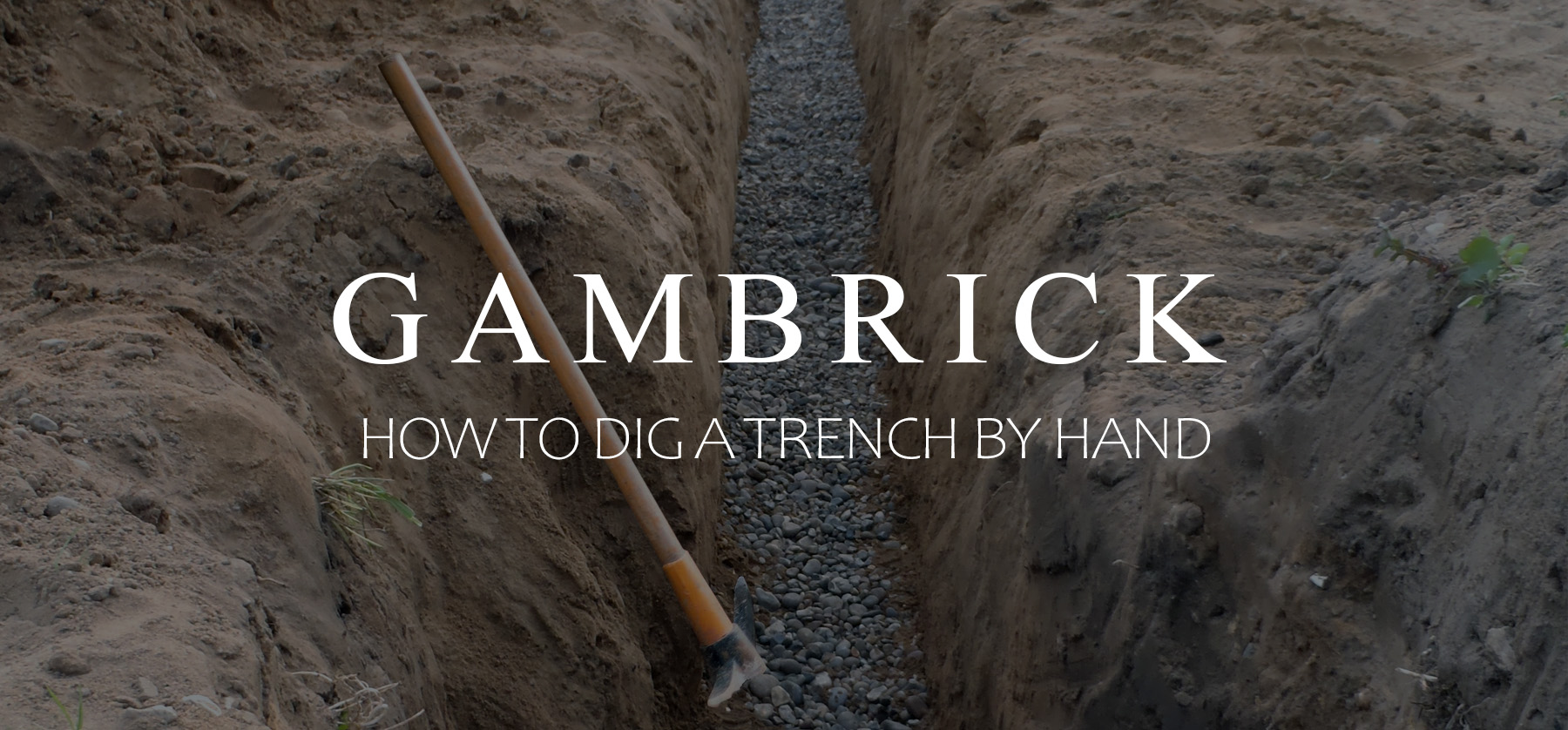How To Dig A Trench By Hand
Digging a trench by hand requires hard work, the right tools and a bit of knowledge. I’ve been working in construction for over 20 years and have dug dozens of trenches to run pipe and electrical conduit or to pour a footing. When you dig a trench by hand, start by softening the ground with a pickaxe. This is especially important in cold months when the top layer of soil is hardest. Once the dirt is loose, start shoveling with a trench or pointed shovel. Use a hoe to clear out loose dirt and rocks. When the trench is deep enough, use a flat head shovel to shape the sides and bottom. This is very important if the trench is for concrete.
Before you start digging, make sure the trench doesn’t run into any underground utilities. Call 811 or your local utility companies for a mark-out before you dig. Then mark the trench path with either stakes and string or paint. Use a measuring tape to make sure it’s the right size.
I use the trench and pointed shovel for the bulk of the work. Any time the soil gets hard to dig, switch to the pickaxe and break it up. Then switch back to the shovels again.
Use a 60 inch pinch point demo bar to break up and pry loose especially hard areas of dirt or large rocks.
Check the trench’s depth with your measuring tape as you dig. Use a long level to check the angle of the trench if you need it pitched for drainage.
Haul dirt away with a wheel barrow. Compact the dirt after you back-fill the trench with a hand tamper.
Don’t forget to wear gloves. Digging a trench by hand can quickly cause blisters and injured hands. They also come in handy if you have to lift rocks or other debris out of the trench. I also recommend wearing a good pair of work boots.
Tools You’ll Need To Dig A Trench By Hand
It takes a variety of tools to effectively dig a trench by hand. Each tool on the list serves a different purpose and makes the job a little easier.
Here is a list of what you’ll need:
- Marking Paint: Spray paint the edges of the trench path.
- Stakes & String: Stakes & string can mark the trench if you don’t have paint.
- Trenching Shovel: A long and slim pointed shovel used to dig trenches.
- Pointed Shovel: A standard pointed shovel used to dig dirt.
- Flat Head Shovel: Use it to shape the sides and bottom of the trench.
- Pickaxe: The pick side is great for breaking up hard ground or prying up rock. The mattock side is for cutting through tough roots.
- Hoe: Use it to gather and move loose dirt. You can also chop down into the trench and pull dirt out. This is an easy way to dig a shallow trench.
- Measuring Tape: Used to mark the size of the trench and check the depth.
- Level: An essential tool if trench needs to be pitched.
- 60 Inch Bar: I always bring a 60″ bar with me when digging trenches to pry or break up really hard rock.
- Wheel Barrow: Used to haul dirt and the tools.
- Hand Tamper: Compact the trench after you back-fill.
- Gloves: Digging a trench by hand without gloves will quickly cause blisters for most people.
- Tarp: Keep a tarp handy to cover the trench if it rains or else you’ll be digging in a mud pit.
- Boots: Work boots are not essential but I recommend wearing them.
- Laser Transom: A great way to check the depth and pitch of large trenches.
Even with the right tools and a bit of knowledge, digging a trench by hand is still hard work. Especially if you’ve got really hard ground like clay or caliche. Each tool is designed for a different purpose and work together to dig the trench. If you try to do it with just a single shovel you’ll find it a lot harder to do.
Call Before You Dig A Trench
Before you start digging anywhere on your property, make sure the trench won’t run into any underground utilities like water, power or gas. If you’re in the United States, dial 811 to notify utility providers where and when you’ll be digging. They’ll come to your property free of charge and mark any underground utilities that could be in your way.
Keep in mind that 811 only notifies utility companies to mark their respective lines, this does not include a septic tank or any lines running from the tank to the house. If your properly has a septic tank, you have to notify the septic company by yourself.
You could also notify utility companies by yourself with a phone call.
- Call 811 a few days before you dig.
- Don’t dig until all the utilities have been marked.
- Calling 811 is a free service.
- If you dig without notifying the utility companies and hit a line, you may be liable for repair costs.
- 811 Does not include septic. You must notify the septic company on your own.
Never dig without notifying the utility companies of your plans. If you hit a line, you may be liable for repair costs. It also could be very dangerous if you accidentally puncture a power or gas line.
Mark The Trench Path
Use a tape measure, marking paint or stakes and string to mark the trench path.
If you’re using paint, mark the exact edge of the trench. Then start digging along the paint line. However if you’re marking with string, place the stakes about 6-8 inches from the edge of the trench. In construction this is called a setback.
A setback is important when using string because digging too close to the stakes can undermine them.
There are pros vs cons of each marking method.
Marking Paint: Lets you mark the exact outline of the trench. But when you dig the marks are erased. If you run off the line you won’t know it because the reference marks are erased when you dig. Another problem is loose dirt. As you dig the trench and toss dirt it’s easy to cover the marks. Paint is better for curved trenches.
Stakes & String: The stakes and string stay in even after you dig the trench so you always have a reference point to measure off of. However it takes longer to stake the ground and tie string vs paint and they can get in the way as you work. It’s harder to marked a curved trench with string.
- Mark your trench path clearly with paint or string.
- Plan your trench dimensions first on paper, then transfer the plan to the ground with markings.
- Use the tape measure to ensure your marks are in the right place.
Marking the trench with either paint or string helps create a more uniform and professional trench. This is very important if you’re digging on a property with tight setbacks and rules governing where you can dig. Without a clear marking, it’s more difficult to dig a trench that follows a designated path.
Start Digging With A Trenching Shovel
Once the trench path is marked, begin excavating with a trenching shovel. Its long slender design and triangle pointed tip can easily pierce most soil types. Dig the edges of the trench a few inches deep first. Then start digging the center.
A trenching shovels angular tip is great for cutting through grasses and roots.
A trench shovel digs much faster than a standard pointed shovel if the ground is hard. However, if the ground is soft, sandy and/or easy to dig, switch to a pointed shovel. They’re bigger and move more dirt per shovel full.
Because trench shovels are so thin, they’re better at digging the edge vs a regular pointed shovel.
I usually use the trench shovel the dig the outer line, following my paint or string, then switch to the pointed shovel to dig the inside.
If the dirt is really hard to dig, use the pickaxe. This is especially important in Winter when the ground is hardest or in tough soil like caliche.
Dig With A Pickaxe When Soil Gets Tough & Rocky
A pickaxe is an essential tool when digging a trench by hand. If you encounter roots, rocks, or really tough soil, loosen it up with the pickaxe, not a shovel. A pickaxe loosens rocks and hard soil by getting underneath and prying the obstruction loose.
If the top layer of grass and roots are really thick, turn them over with the pickaxe before you start digging. It’ll make your work much easier.
Use a tool called a pick mattock or pickaxe mattock. It has a pointed side and a flat side. The pointed side is great for lodging under rocks or hard ground and prying them free. The mattock side is flat and used for chopping through roots.
- Keep hitting and prying the area with your pickaxe until the soil becomes soft enough to dig with a shovel.
- Use the flat head shovel to remove loose bits of rock and soil you loosened with the pickaxe.
- The mattock side is also great at digging chunks out of dense soil like clay where a shovel can struggle.
- It’s also great for shaping and widening trenches if you’re skilled at swinging it.
- Take advantage of a pickaxe’s curved head design. Lodge one end under a rock and pry it loose by pushing and pulling the handle. This uses leverage and mechanical advantage rather than muscle.
Be careful when swinging a pickaxe, they’re heavy and dangerous tools. I’ve seen many people injure themselves or others by swinging a pickaxe carelessly.
Pickaxe Mattocks come in different sizes. I prefer a 36 inch handle with a 5 lb head.
Use A Hoe To Clear Loose Dirt & Shape The Trench
A hoe is a great tool for moving loose dirt at the bottom of a trench into a pile where you can then shovel it out. It’s also good for shaping the tench or breaking up bits of soft to medium dense soil. I use my how while digging the trench and at the very end to shape the sides and bottom of the trench and clean up loose dirt.
A hoe is shaped differently than a pickaxe or shovel and works at angles the other two tools won’t.
Hoes are great for breaking up the very top layer of a trench that’s generally made up of grass, roots and rocks.
Dig A Shallow Drainage Trench With A Trenching Hoe
A trenching hoe is a 6 to 8 inch wide steel hoe with a 36 inch handle. You can use it to chop down into the soil and pull dirt back and away from the trench. This is a great way to dig a shallow, narrow trench for drainage because you can use a hoe that’s the exact width of the trench. But if you’re trench is deep and/or wide, you’ll need shovels instead.
Hoes are great for breaking up the very top layer of a trench that’s generally made up of grass, roots and rocks.
Use A 60″ Bar To Pry Heavy Rock
If you encounter a heavy rock or really hard section of soil, use a 60″ pinch point demo bar to pry them loose. Stab the bar into the soil while you push and pull sections loose. Repeat the process to jar loose tough sections or rocky or clay filled soil. Then use a shovel to dig out the areas you just loosened up.
A bar is very helpful in really hard soil like caliche that needs to be chipped loose a little at a time. Drive the pointed end of the bar into the caliche and then pull it towards you. This will chip sections of soil loose a little at a time.
A bar is also good at prying loose debris from a trench. I’ve dug many trenches that were filled with old construction debris like blocks, brick, pavers and concrete. The bar can pry them loose so you can haul them out.
Check The Trench Depth & Pitch
As you dig, check the trench’s depth with your tape measure. Make sure to measure from the top of virgin soil and not the dirt you’ve been digging out. Check the width of the trench at the top and bottom points. It’s very common to have a wider top than bottom.
If the top of your trench is wider than the bottom, shape the sides with your shovel.
If the property is level, you can check the pitch of the trench with a tape measure. A common pitch for a drainage trench is about 1/8 inch of pitch per 1 linear feet. This is also known as a 1% pitch.
Another way to check pitch is with a long level. I always bring one with me whenever I dig a trench just in case the ground isn’t perfectly level. Which it usually isn’t. A 6 to 8 foot framing level works great.
If you don’t have a long level, use a really straight beam instead. Place the beam inside the trench with the level on top. The level will show the pitch of the beam and essentially become a long level.
You can also use a laser transom to check the pitch and depth of a trench. They’re especially useful if the trench is really large or has lots of curves. You can rent one at some Home Depots or other tool rental places.
- Use a tape measure to check pitch if the ground is level.
- You can use a a long level to check pitch if the ground is level or not.
- Use a short level on top of a long straight beam to check pitch.
- A laser transom is great for checking pitch when the trench is curved or really large.
Have A Plan For All That Dirt
A lot of soil comes out of the ground when you dig a trench. Before you start digging, have a plan for not only the trench but also what you’ll do with all that dirt. Even if you’re back-filling the trench after burying a drainage pipe or utility line, there will still be some excess dirt because of whatever you buried in the trench.
- If you plan on hauling the dirt away, bring a wheel barrow.
- Use a rake to spread the dirt out if you’re keeping it in place.
Soil that’s in the ground is compacted over time. Even sandy soil is still tightly compacted. When you shovel it out, the dirt becomes looser which means it expands. Once you shovel dirt out of the ground it typically takes up about 1/4 more volume.
Compact The Trench After Back-Fill
Once you’re all done digging the trench, laying your stone, drainage pipe, utilities or whatever is going in the trench, fill it back in with dirt. Then compact the dirt with a tamper. Dirt that’s in the ground is about 25% denser than dirt that’s been shoveled because it’s been compacted.
If you don’t tamp down the trench after back-filling, it’ll compact itself over time. The result will be low ground that pools lots of water.
Tamp the entire trench with your hand tamper and then back-fill again. When you tamp dirt it’ll go down a few inches in height. Keep adding dirt and tamping until you can walk on the trench without sinking in.
Sprinkle some water over the trench and leave it overnight. Then tamp again in the morning. Whatever helps compact the dirt tighter than you can do by hand. Repeat this a few times until the ground won’t compact any more.
What’s The Fastest Way To Dig A Trench By Hand?
The fastest way to dig a trench by hand is by using a variety of tools instead of just a single shovel. Different digging tools are all designed to work in different ways. When you dig a trench, you may encounter soft, medium and hard soil, clay, rocks, debris, roots and other potential issues. You need the right tools to deal with whatever you find under the ground.
- A trenching and standard pointed shovel are the best all around tools for digging a trench by hand and will generally do most of the work. They both have pointed tip which makes shoveling into hard dirt and cutting through grass easier.
- Use a regular flat head shovel to shape the trench, level the bottom and scoop up loose dirt.
- A hoe is great for shaping the trench and moving loose dirt.
- Use a pickaxe mattock to break up hard soil or chop through tough roots. You can also use its curved head to pry up rocks or other heavy objects.
- I always bring a 60″ pointed demo bar to pry really heavy objects or to break up extremely hard dirt like caliche.
- Don’t forget a level or transom to check the trench pitch.
- Use a tape measure to check depth.
- Mark the trench with paint or string.
Once you’ve got your tools ready and the trench marked, here are a few tips to speed things up:
- Water the soil for 15-20 minutes the day before excavation.
- Use a trenching and pointed shovel to dig the bulk of the trench.
- A pick mattock and 60″ bar will pry up rocks and break through tough soil.
Moist soil is usually easier to dig than hard, dry ground. But don’t get it too wet or it’ll become muddy.
Is It Easier To Dig Through Wet Or Dry Dirt?
It depends on the type of dirt you’re digging. If the dirt is soft, sandy and easy to dig, it’s easier to dig through if it’s dry. Water just adds weight to every shovel full. However, if the ground is really dense and hard, a small amount of water the night before can help soften the ground making it easier to dig.
Really wet or muddy soil is extremely heavy to dig. Wait for it to dry out a bit before digging your trench.
How Long Does It Take To Dig A Trench By Hand?
It takes about 1 hour per 10 feet of trench at 1 foot deep and 8 inches wide. This is fairly shallow rough trench that’s good for drainage pipe but not utilities or a footing. However the speed at which you can dig a trench depends on the soil type, weather, depth, width and what’s in the soil. If it’s really hard ground like caliche or contains solid rock you’ll be lucky to dig a foot or two per hour. Complex trenches also take more time to dig. A straight trench is much easier to dig than one with angles or curves.
What Is The Best Tool To Dig A Trench?
The best tool to dig a trench is a trench shovel. It has a long and thin pointed head that’s great for digging through tough ground or chopping roots. Next would be a standard pointed shovel which is best for moving large amounts of soft to medium density soil. You’ll also need a pickaxe mattock to pry up large rocks or break through especially hard ground.
A few other tools are also essential like a tape measure, marking paint or string and a level if you want to pitch the trench.
What’s The First Thing To Do When Digging A Trench By Hand?
The first thing you do when digging a trench by hand is planning. I always draw a plan of my trench including all curves and angles on paper. Then I use some paint or string to mark the trench path on the ground. Once that’s done, gather all your tools and start digging. Check the trench depth and width as you dig to keep it even and at the correct depth.
How Do You Dig A Drainage Ditch By Hand?
Here’s a step by step outline of how to effectively and efficiently dig a trench by hand as fast as possible:
- Gather the following tools: trenching shovel, pickaxe mattock, hoe, pointed shovel, flat head shovel, 60″ bar, measuring tape, level or transom, marking paint or string.
- Call 811 before digging to mark underground utilities.
- Mark your trench path with string or paint.
- Start by excavating the sides of the trench with the trenching shovel. If the ground is really hard use the pickaxe.
- Once the outline of the trench is done, use the trenching shovel to start excavating the middle section.
- Remove to top layer of soil that contains grass and roots first. Then start working on soil. The top layer is usually harder to dig.
- Use a pickaxe and/or 60″ bar to remove rocks, chop roots, and break up tough ground.
- Move loose dirt and clean up the trench with your hoe
- Use the flat head shovel to shape the trench.
- Check the trench depth with your measuring tape.
- Make sure the trench is pitched correctly with the transom or level.
To speed up the process, lightly water the area the night before you dig. Moist dirt is usually easier to dig than dry hard soil.
Most drainage ditches are only about 8 to 12 inches deep by 8 inches wide. This is wide and deep enough for a 4 to 8 inch diameter hard drainage pipe.
Summary: How To Dig A Trench By Hand
Digging a trench by hand requires hard work, the right tools and a bit of knowledge. I’ve been working in construction for over 20 years and have dug dozens of trenches to run pipe and electrical conduit or to pour a footing. When you dig a trench by hand, start by softening the ground with a pickaxe. This is especially important in cold months when the top layer of soil is hardest. Once the dirt is loose, start shoveling with a trench or pointed shovel. Use a hoe to clear out loose dirt and rocks. When the trench is deep enough, use a flat head shovel to shape the sides and bottom. This is very important if the trench is for concrete.
Before you start digging, make sure the trench doesn’t run into any underground utilities. Call 811 or your local utility companies for a mark-out before you dig. Then mark the trench path with either stakes and string or paint. Use a measuring tape to make sure it’s the right size.
I use the trench and pointed shovel for the bulk of the work. Any time the soil gets hard to dig, switch to the pickaxe and break it up. Then switch back to the shovels again.
Use a 60 inch pinch point demo bar to break up and pry loose especially hard areas of dirt or large rocks.
Check the trench’s depth with your measuring tape as you dig. Use a long level to check the angle of the trench if you need it pitched for drainage.
Haul dirt away with a wheel barrow. Compact the dirt after you back-fill the trench with a hand tamper.
Don’t forget to wear gloves. Digging a trench by hand can quickly cause blisters and injured hands. They also come in handy if you have to lift rocks or other debris out of the trench. I also recommend wearing a good pair of work boots.
If you have any questions about how to dig a trench by hand, email any time.





















